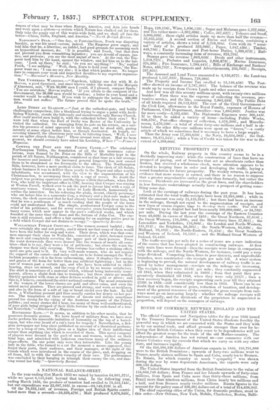REVIVING PROSPERITY OF RAILWAYS.
On the whole, Railway property in this country seems to be in a decidedly improving state : while the construction of lines that have no prospect of paying, and of branches that act as absorbents rather than feeders, has received a wholesome check, more attention appears to be devoted to keeping lines in order and developing the traffic, laying a sound foundation for future prosperity. The weekly returns, in general, evidence that more money is earned, and there is no reason to suppose that a greater unproductive outlay prevails than formerly, but rather the reverse. Dividends are increased on the great lines, and the shareholders in less fortunate undertakings actually have a prospect of getting something some day. Look at the earnings of railways during the past year. It has been estimated that the total traffic-receipts have been 22,005,5001.; while in 1856 the amount was only 21,123,3151.; but there had been an increase in the mileage, though not equal to the augmentation of receipts, and new lines of course require time to dcraup akelk Liam°. The cost ot our railways up to August last had been nearly 300,000,000/., or 34,782/. per mile. During the last year the earnings of the Eastern Counties were 49,668/. in excess of those of 1855; the Great Northern, 57,6141.; the Great Western, 116,599/., and the Shrewsbury lines 37,8011.; the Lancashire and Yorkshire, 116,8001.; the London and North-Western, 131,2121.; the Brighton, 58,5911.; the South-Western, 85,9291.; the Midland, 03,4821.; the North-Eastern' 51,4541.; the Great Southern and Western of Ireland, 16,1311.; amid the Midland Great Western of Ireland, 25,449/.
The traffic-receipts per mile for a series of years are a sure indication of the course that has been adopted in constructing railways. At }list only main lines were formed—then the receipts were large in comparison with the mileage' and the North-Western, for instance, could pay a very large dividend. Competing lines, lines in poor districts, and unprofitable branches, were constructed—the receipts per mile fell. A wiser system
beginning to prevail, the natural development
t of railway traffic s assisted by better management—receipts on the mileage are increasing. The receipts in 1842 were 3118/. per mile ; they constantly augmented till 1845, when they culminated in 34691.; from that point they progressively diminished till 1850, when they were only 2227!.; then a slow recovery began, the receipts augmenting each year till they attained 2759/. in 1856—still considerably less than in 1845. There can be no doubt that with the return of peace, reduction of taxation, and development of the general resources of the countiy, the gross receipts from railways must go on increasing largely : whether the mileage receipts will increase equally, and the dividends of the proprietors be augmented in proportion, will depend on the managers of railways.


































 Previous page
Previous page